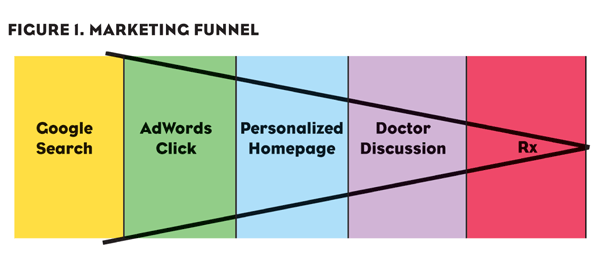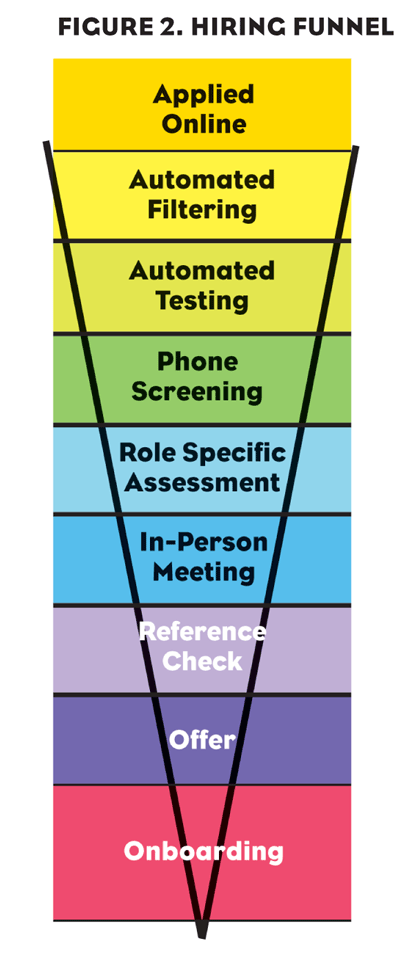Hiring is the most important thing you can ever do to future-proof your organization. Having the right people on your team isn’t just “a nice to have”—it’s an absolutely critical ingredient in your company’s success. We believe that hiring the wrong person today is literally borrowing from your future by solving an immediate problem while creating a much larger problem later on.
We put so much importance on hiring that it is the number one priority for our senior leadership team and a very significant goal for every one of our 400 plus people. Based on the principles included in our New York Times bestselling book The Decoded Company (Portfolio/Penguin), we have engineered a hiring toolset and ecosystem to ensure a constant flow of awesome new team members. Our process is not unique to the agency world, but rather can be immediately applied to any business in any industry.
The Hiring Funnel
Given our background and extensive experience in digital marketing, it’s perhaps unsurprising that we approach hiring with the same perspective with which we would tackle a marketing challenge from our clients.
We tend to see the world as a series of conversion funnels, optimized to “convert” someone from one behavior or designation to another. In the case of a brand website for patients, it might be to convert a consumer researching a condition into a motivated brand requester with a completed doctor discussion guide.
When we think about hiring, we go all the way to the beginning and start with someone submitting a resume and application to our website and then track them all the way through their journey to becoming a valuable member of the Klick team. For now, think of this as a linear journey, illustrated as such:
Hiring Journey
Most companies have a hiring process that adds in at least a few steps. They might do a phone screen, followed by an in-person interview, followed by a reference check. Let’s call this a standard approach:
“Standard” Hiring Approach
There is an implicit positive pressure to this line, pushing candidates through. People tend to inherently assume that they want to move a potential hire all the way to the valuable team member stage and that it’s a question of choosing between a number of qualified candidates. They may even go out of their way to expedite this process, favoring their short-term gain in time rather than the long-term gain in true value to the team.
Consider this alternative. David Ogilvy, in many ways the father of modern agencies, once said, “If each of us hires people who are smaller than we are, we shall become a company of dwarfs. But if each of us hires people who are bigger than we are, we shall become a company of giants.”
Because we’re somewhat data obsessed, we like to think of this more in terms of an equation: A players hire A players while B players hire C’s. In other words, your top people (the A’s) will want to surround themselves with people stronger than they are so that they can be continually inspired and learn new things. Everyone below them (the B’s) spends more time fearing for their job than they do executing at peak performance. Consider how a lack of job security can quickly become a factor in every decision you make including the people you choose to surround yourself with. If you truly lack confidence in your ability to perform, you want to surround yourself with people who execute at a lower level to ensure that you stand out.
In order to find the first set of A players (and to identify your current A’s internally), you can turn to the power of Big Data. We love data in virtually every form, from the performance of our clients’ campaigns and businesses to the flow of candidates through our hiring funnel, to the number of coffees brewed by all of the coffee makers in our building (2013 was a banner year at 62,329). Let’s look at the patient website conversion funnel (Figure 1) we addressed earlier.
This is obviously a simplified example, but you can see how each of the vertical lines represents a conversion opportunity at which we will inevitably experience some drop-off. Not everyone who searches for our keywords will click on our ads. Not everyone who gets to the website will complete the guide. Not everyone who completes the guide will actually take it to their doc and walk out with a scrip. It’s in our best interest, though, to positively pressurize the system so that as many Google searchers as possible end up on scrip. We measure every aspect of the conversion funnel, especially at the vertical lines, to optimize the number of people who make it to the next step without dropping out.
The opposite of positive pressure is obviously negative pressure. In order to find those A players—the signals hidden among all the noise—you have to find a way to change the signal-to-noise ratio. We apply a noise filter by pressurizing the funnel in the opposite direction: We want to make it very difficult to move through to the end and we want to increase drop off at each point as much as possible. Our funnel gets a lot more steps in it as a result (see Figure 2).
These extra steps, combined with negative pressure, mean that we can go from close to 10,000 applications to 100 very high-quality hires in less than a month. Our tools and automation take the manual labor out of the equation, meaning our people can focus on teasing out the signal and don’t have to worry about the noise.
Many of our clients face their biggest hiring challenges when they begin to assemble a commercial team for a new molecule’s launch. If they’re an emerging biotech commercializing for the first time, they’re about to double in size and change their focus from research and development to sales and marketing. The challenge of hiring that many new people at the same time runs the risk of adding a considerable amount of unproven talent (the so-called “newbie ratio”), creating silos and communication breakdowns and radically changing the culture built up over their R&D lifespan. Building the right hiring funnel, with the right tools and processes in place, can instead build an incredibly fast organization able to achieve at a much higher level.










